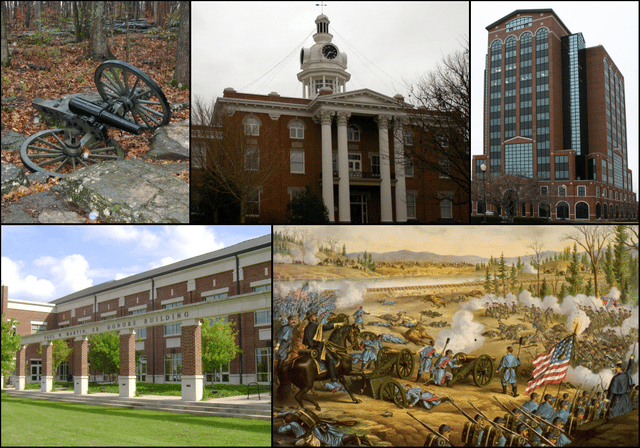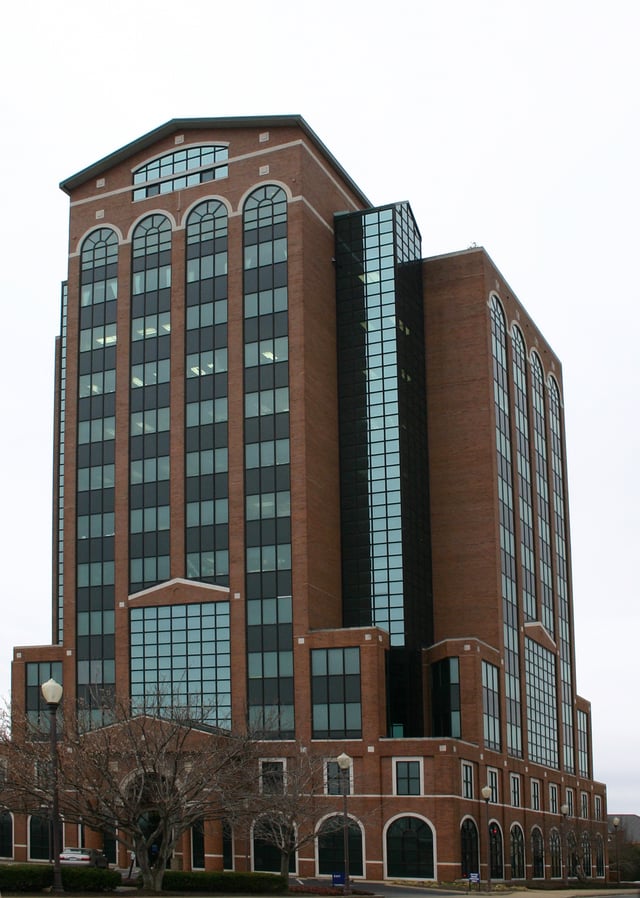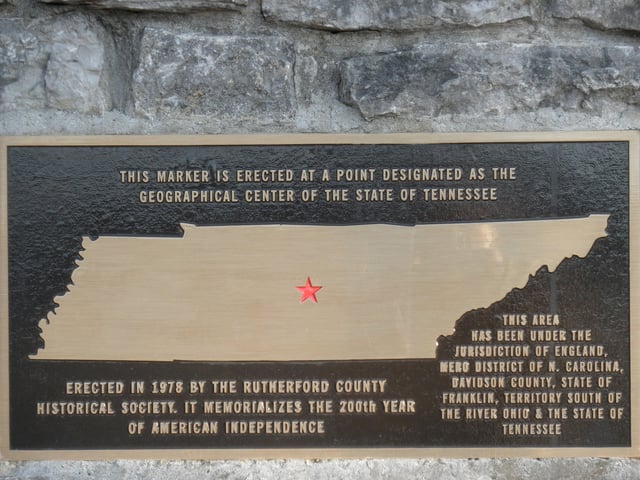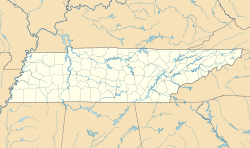Murfreesboro, Tennessee

Murfreesboro, Tennessee

Murfreesboro, Tennessee | |
|---|---|
City | |
| City of Murfreesboro | |
| Nickname(s): "The 'Boro" | |
| Motto(s): Creating a better quality of life. | |
 Location of Murfreesboro in Rutherford County, Tennessee. | |
| Coordinates:35°50′46″N 86°23′31″W [80] | |
| Country | United States |
| State | Tennessee |
| County | Rutherford |
| Settled | 1811 |
| Incorporated | 1817 |
| Government | |
| • Type | Council–Manager[1] |
| • Mayor | Shane McFarland (R)[2] |
| • Vice mayor | Madelyn Scales Harris[3] |
| • City manager | Craig Tindall[4] |
| Area | |
| • City | 58.47 sq mi (151.43 km2) |
| • Land | 58.32 sq mi (151.06 km2) |
| • Water | 0.15 sq mi (0.37 km2) 0.25% |
| Elevation | 610 ft (186 m) |
| Population | |
| • City | 108,755 |
| • Estimate (2018)[6] | 141,344 |
| • Rank | US: 188th |
| • Density | 1,900/sq mi (720/km2) |
| • Urban | 133,228 (US: 241st) |
| Time zone | UTC−6 (CST) |
| • Summer (DST) | UTC−5 (CDT) |
| ZIP Codes | 37127-37133 |
| Area code(s) | 615, 629 |
| FIPS code | 47-51560 |
| GNIS feature ID | 1295105[7] |
| Website | City of Murfreesboro [81] |
Murfreesboro is a city in, and the county seat of, Rutherford County,[8] Tennessee, United States. The population was 108,755 according to the 2010 census, up from 68,816 residents certified in 2000. In 2018, census estimates showed a population of 141,344.[6] The city is home to both the center of population of Tennessee[9] and the geographic center of Tennessee. Its location is 34 miles (55 km) southeast of downtown Nashville within the Nashville metropolitan area of Middle Tennessee. It is Tennessee's fastest growing major city and one of the fastest growing cities in the country.[10] Murfreesboro is also home to Middle Tennessee State University, the second largest undergraduate university in the state of Tennessee, with 22,729 total students as of fall 2014.[11]
Murfreesboro, Tennessee | |
|---|---|
City | |
| City of Murfreesboro | |
| Nickname(s): "The 'Boro" | |
| Motto(s): Creating a better quality of life. | |
 Location of Murfreesboro in Rutherford County, Tennessee. | |
| Coordinates:35°50′46″N 86°23′31″W [80] | |
| Country | United States |
| State | Tennessee |
| County | Rutherford |
| Settled | 1811 |
| Incorporated | 1817 |
| Government | |
| • Type | Council–Manager[1] |
| • Mayor | Shane McFarland (R)[2] |
| • Vice mayor | Madelyn Scales Harris[3] |
| • City manager | Craig Tindall[4] |
| Area | |
| • City | 58.47 sq mi (151.43 km2) |
| • Land | 58.32 sq mi (151.06 km2) |
| • Water | 0.15 sq mi (0.37 km2) 0.25% |
| Elevation | 610 ft (186 m) |
| Population | |
| • City | 108,755 |
| • Estimate (2018)[6] | 141,344 |
| • Rank | US: 188th |
| • Density | 1,900/sq mi (720/km2) |
| • Urban | 133,228 (US: 241st) |
| Time zone | UTC−6 (CST) |
| • Summer (DST) | UTC−5 (CDT) |
| ZIP Codes | 37127-37133 |
| Area code(s) | 615, 629 |
| FIPS code | 47-51560 |
| GNIS feature ID | 1295105[7] |
| Website | City of Murfreesboro [81] |
History
On October 27, 1811, the Tennessee General Assembly designated the location for a new county seat for Rutherford County, giving it the name Cannonsburgh in honor of Newton Cannon, then-representative to the Assembly for the local area. At the suggestion of William Lytle, it was renamed Murfreesborough on November 29, 1811, after Revolutionary War hero Colonel Hardy Murfree.[15] The name was shortened to Murfreesboro in January 1812 when the town was formally chartered.[16][17] Author Mary Noailles Murfree was his great-granddaughter.
As Tennessee settlement expanded to the west, the location of the state capital in Knoxville became inconvenient for most newcomers. In 1818, Murfreesboro was designated as the capital of Tennessee and its population boomed. Eight years later, however, it was itself replaced by Nashville.[18]
Civil War
On December 31, 1862, the Battle of Stones River, also called the Battle of Murfreesboro, was fought near the city between the Union Army of the Cumberland and the Confederate Army of Tennessee. This was a major engagement of the American Civil War, and between December 31 and January 2, 1863, the rival armies suffered a combined total of 23,515 casualties.[19] It was the bloodiest battle of the war by percentage of casualties.
Following the Confederate retreat after the drawn Battle of Perryville in central Kentucky, the Confederate army moved through East Tennessee and then turned northwest to defend Murfreesboro. General Braxton Bragg's veteran cavalry successfully harassed Union General William Rosecrans' troop movements, capturing and destroying many of his supply trains. However, they could not completely prevent supplies and reinforcements from reaching Rosecrans. Despite the large number of casualties, the battle was inconclusive. Nevertheless, it is usually considered a Union victory, since afterwards General Bragg retreated 36 miles (58 km) south to Tullahoma. Even so, the Union army did not move against Bragg until a full six months later in June 1863. The battle was significant since it did provide the Union army with a base to push the eventual drive further south, which allowed the later advances against Chattanooga and Atlanta. These eventually allowed the Union to divide the Eastern and Western theaters, followed by Sherman's March to the Sea. The Stones River National Battlefield is now a national historical site.
General Rosecrans' move to the south depended on a secure source of provisions, and Murfreesboro was chosen to become his supply depot. Soon after the battle, Brigadier General James St. Clair Morton, Chief Engineer of the Army of the Cumberland, was ordered to build Fortress Rosecrans, some 2 miles (3.2 km) northwest of the town. The fortifications covered about 225 acres (0.91 km2) and were the largest built during the war. Fortress Rosecrans consisted of eight lunettes, four redoubts and connecting fortifications. The Nashville and Chattanooga Railroad and the West Fork of the Stones River both passed through the fortress, while two roads provided additional transportation.
The fort's interior was a huge logistical resource center, including sawmills, warehouses, quartermaster maintenance depots, ammunition magazines, and living quarters for the 2,000 men who handled the operations and defended the post. The fortress was completed in June 1863, and only then did Rosecrans dare to move south.[20] The fortress was never attacked, in part because the Union troops held the town of Murfreesboro hostage by training their artillery on the courthouse. Major portions of the earthworks still exist and have been incorporated into the battlefield site.
Post-Civil War
Murfreesboro had begun as a mainly agricultural community, but by 1853 the area was home to several colleges and academies, gaining the nickname the "Athens of Tennessee". Despite the wartime trauma, the town's growth had begun to recover by the early 1900s, in contrast to other areas of the devastated South.
In 1911, the state legislature created Middle Tennessee State Normal School, a two-year institute to train teachers. It would soon merge with the Tennessee College for Women. In 1925 the Normal School was expanded to a four-year college. In 1965 it became Middle Tennessee State University.[21] MTSU now has the largest undergraduate enrollment in the state, including many international students.
World War II resulted in Murfreesboro diversifying into industry, manufacturing, and education. Growth has been steady since that time, creating a stable economy.
Murfreesboro has enjoyed substantial residential and commercial growth, with its population increasing 123.9% between 1990 and 2010, from 44,922 to 100,575.[22] The city has been a destination for many immigrants leaving areas affected by warfare; since 1990 numerous Somalis and Kurds from Iraq have settled here. The city has also become more cosmopolitan by attracting more numerous international students to the university.
Government
The city council has six members, all elected at-large for four-year terms, on staggered schedules with elections every two years. The mayor is elected at large. City council members have responsibilities for various city departments.
David Wendel, 1819
Robert Purdy, 1820
Henry Holmes, 1821
W. R. Rucker, 1822-1823
John Jones, 1824
Wm. Ledbetter, 1825, 1827
John Smith, 1828, 1830
Edward Fisher, 1829, 1836, 1839
James C. Moore, 1831
Charles Ready, 1832
Charles Niles, 1833
Marman Spence, 1834
M. Spence, 1835
L. H. Carney, 1837
Edwin Augustus Keeble, 1838, 1855
G. A. Sublett, 1840
B. W. Farmer, 1841-1842, 1845-1846
Henderson King Yoakum, 1843
Wilson Thomas, 1844
John Leiper, 1847-1848
Charles Ready, 1849-1853, 1867
F. Henry, 1854
Joseph B. Palmer, 1856-1859
John W. Burton, 1860-1861
John E. Dromgoole, 1862
James Monro Tompkins, 1863-1864
R. D. Reed, 1865-1866
E. L. Jordan, 1868-1869
Thomas B. Darragh, 1870
Joseph A. January, 1871
I. B. Collier, 1872-1873
J. B. Murfree, 1874-1875
H. H. Kerr, 1876
H. H. Clayton, 1877
N. C. Collier, 1878-1879
Jas. Clayton, 1880-1881
E. F. Burton, 1882-1883
J. M. Overall, 1884-1885
H. E. Palmer, 1886-1887
Tom H. Woods, 1888-1895
J. T. Wrather, 1896-1897
J. O. Oslin, 1898-1899
J. H. Chrichlow, 1900-1909
G. B. Giltner, 1910-1918
N. C. Maney, 1919-1922, 1932-1934
Al D. McKnight, 1923-1931
W. T. Gerhardt, 1934-1936, 1941-1942
W. A. Miles, 1937-1940, 1943-1946
John T. Holloway, 1947-1950
Jennings A. Jones, 1951-1954
A. L. Todd, Jr., 1955-1964
William Hollis Westbrooks, 1965-1982[25]
Richard Reeves, 1998-2002[25]
Tommy Bragg, 2002-2014[28]
Shane McFarland, 2014–present[29]
Geography

City Center, built by Joseph Swanson, a major developer in the area.

Plaque on a stone monument erected in 1978 designating the geographic center of Tennessee.
According to the United States Census Bureau, the city has a total area of 39.2 square miles (102 km2). 39.0 square miles (101 km2) of it is land and 0.2 square miles (0.52 km2) of it (0.54%) is water. However, as of 2013 the city reports its total area as 55.94 square miles (144.9 km2).[31] []
Murfreesboro is the geographic center of the state of Tennessee. A stone monument marks the official site on Old Lascassas Pike, about 0.5 miles (0.80 km) north of MTSU.
The West Fork of the Stones River flows through Murfreesboro. A walking trail, the Greenway, parallels the river for several miles. A smaller waterway, Lytle Creek, flows through downtown including historic Cannonsburgh Village. Parts of the 19-mile (31 km) long creek suffer from pollution due to the urban environment and its use as a storm-water runoff.[32]
Murfreesboro has been in the path of destructive tornados several times. On April 10, 2009, an EF4 tornado struck the fringes of Murfreesboro. As a result, two people were killed and 41 others injured. 117 homes were totally destroyed, and 292 had major damage. The tornado is estimated to have caused over $40 million in damage.[35]
Transportation
Murfreesboro is served by Nashville International Airport (IATA code BNA), Smyrna Airport (MQY) and Murfreesboro Municipal Airport (MBT). The city also benefits from several highways running through the city, including Interstates 24 and 840; U.S. Routes 41, 70S, and 231; and State Routes 1, 2, 10, 96, 99, and 268. Industry also has access to North-South rail service with the rail line from Nashville to Chattanooga. Until 1965 the Louisville & Nashville's Chicago-Florida Dixie Flyer made a stop in the town on its route.[36]
Public transportation
In April 2007 the City of Murfreesboro established a public transportation system with nine small buses, each capable of holding sixteen people and including two spaces for wheelchairs. The system is called Rover; the buses are bright green with Rover and a cartoon dog painted on the side. As of 2019, buses operate in seven major corridors: Memorial Boulevard, Gateway, Old Fort Parkway, South Church Street, Mercury Boulevard, Highland Avenue and Westside Loop.[37]
Demographics
| Historical population | |||
|---|---|---|---|
| Census | Pop. | %± | |
| 1850 | 1,917 | — | |
| 1860 | 2,861 | 49.2% | |
| 1870 | 3,502 | 22.4% | |
| 1880 | 3,800 | 8.5% | |
| 1890 | 3,739 | −1.6% | |
| 1900 | 3,999 | 7.0% | |
| 1910 | 4,679 | 17.0% | |
| 1920 | 5,367 | 14.7% | |
| 1930 | 7,993 | 48.9% | |
| 1940 | 9,495 | 18.8% | |
| 1950 | 13,052 | 37.5% | |
| 1960 | 18,991 | 45.5% | |
| 1970 | 26,360 | 38.8% | |
| 1980 | 32,845 | 24.6% | |
| 1990 | 44,922 | 36.8% | |
| 2000 | 68,816 | 53.2% | |
| 2010 | 108,755 | 58.0% | |
| Est. 2018 | 141,344 | [6] | 30.0% |
| Sources: | |||
As of the 2010 census, there were 108,755 people residing in the city. The racial makeup of the city was 75.62% White, 15.18% Black / African American, 0.35% Native American, 3.36% Asian, 0.04% Pacific Islander, 2.79% from other races, and 2.65% from two or more races. Hispanic or Latino of any race were 5.93% of the population.
In the 2000 Census, There were 26,511 households out of which 30.7% had children under the age of 18 living with them, 43.8% were married couples living together, 11.9% had a female householder with no husband present, and 40.6% were non-families. 28.3% of all households were made up of individuals and 7.0% had someone living alone who was 65 years of age or older. The average household size was 2.42 and the average family size was 3.02.
In the city, the population was spread out with 22.7% under the age of 18, 20.5% from 18 to 24, 30.8% from 25 to 44, 17.3% from 45 to 64, and 8.8% who were 65 years of age or older. The median age was 29 years. For every 100 females, there were 98.7 males. For every 100 females age 18 and over, there were 97.2 males.
The median income for a household in the city was $39,705, and the median income for a family was $52,654. Males had a median income of $36,078 versus $26,531 for females. The per capita income for the city was $20,219. About 8.2% of families and 14.1% of the population were below the poverty line, including 12.0% of those under the age of 18 and 11.1% of those 65 and older.
Special census estimates in 2005 indicated 81,393 residents, and in 2006 the U.S. Census Bureau's American Community Survey estimated a population of 92,559, with 35,842 households and 20,979 families in the city.[42] Murfreesboro's 2008 special census reported that the population had reached 100,575,[42] while preliminary information from the 2010 U.S. Census indicates a population of 108,755. In October 2017, the City of Murfreesboro started another special census. Given the continuous growth in the general area, the population is expected to exceed the 2016 estimate of 131,947.[43]
Education
Secondary schools are overseen by Rutherford County Schools, which has 47 schools and a student population of over 44,000.[46]
The Japanese Supplementary School in Middle Tennessee (JSMT, 中部テネシー日本語補習校 Chūbu Teneshī Nihongo Hoshūkō), a weekend Japanese education program, holds its classes in Peck Hall at Middle Tennessee State University, while its school offices are in Jefferson Square.[47]
Parks
Cannonsburgh Village is a reproduction of what a working pioneer village would have looked like from the period of the 1830s to the 1930s. Visitors can view the grist mill, school house, doctor's office, Leeman House, Caboose, Wedding Chapel, and other points of interest. It is also home to the World's Largest Cedar Bucket.[48][49]
Old Fort Park is a 50-acre (200,000 m2) park which includes baseball fields, tennis courts, children's playground, an 18-hole championship golf course, picnic shelters and bike trail.[50]
Barfield Crescent Park is a 430-acre (1,700,000 m2) facility with eight baseball fields, 7 miles (11 km) of biking/running trails, an 18-hole championship disc golf course, and ten picnic shelters.[51]
Murfreesboro Greenway System is a system of greenways with 12 miles (19 km) of paved paths and 11 trail heads.[52] In 2013, the city council approved a controversial 25-year "master plan" to extend the system by adding 173 miles worth of new greenways, bikeways and blueways at an estimated cost of $104.8 million.[53]
Culture
Music
Murfreesboro hosts several music-oriented events annually, such as the Main Street Jazzfest presented by MTSU's School of Music and the Main Street Association each May.[48][54] For over 30 years, Uncle Dave Macon Days has celebrated the musical tradition of Uncle Dave Macon. This annual July event includes national competitions for old-time music and dancing.[48][55]
Because of MTSU's large music program, the city has fostered a number of bands and songwriters, including: Julien Baker, The Protomen, The Tony Danza Tapdance Extravaganza, A Plea for Purging, Self, Fluid Ounces, The Katies, Count Bass D, Destroy Destroy Destroy and The Features.
Arts
Murfreesboro's International FolkFest began in 1982 and is held annually during the second week in June. Groups from countries spanning the globe participate in the festival, performing traditional songs and dances while attired in regional apparel.[59]
Museums
The Discovery Center at Murfree Spring is a nature center and interactive museum focusing on children and families. The facility includes 20 acres (8 ha) of wetlands with a variety of animals.[64]
The Stones River National Battlefield is a national park which memorializes the Battle of Stones River, which took place during the American Civil War during December 31, 1862, to January 3, 1863. The grounds include a museum, a national cemetery, monuments, and the remains of a large earthen fortification called Fortress Rosecrans.[48]
Shopping
There are two main malls located within the city limits. Stones River Mall is a traditional enclosed mall, featuring stores and restaurants such as Forever 21, Aéropostale, Journey's, Hot Topic, Agaci, Dillard's, Buckle, Books-A-Million, Olive Garden, and T.G.I. Friday's.
The Avenue Murfreesboro is an outdoor lifestyle center with such shops as American Eagle, Hollister, Best Buy, Belk, Petco, Dick's Sporting Goods, Express, Mimi's Cafe, Romano's Macaroni Grill, and LongHorn Steakhouse.
The Historic Downtown Murfreesboro district also offers a wide variety of shopping and dining experiences that encircle the pre-Civil War Courthouse.[69]
Media
Murfreesboro is serviced by the following media outlets:
Newspapers:
The Daily News Journal
The Murfreesboro Post
The Murfreesboro Pulse
Sidelines – MTSU student newspaper
Rutherford Source
Radio:
WGNS – Talk radio
WMOT – MTSU public radio station
WMTS-FM – MTSU free-form student-run station
WRHW-LP - 3ABN Radio Christian
TV:
City TV Murfreesboro, Channel 3 – Government-access television channel
MT10, Channel 10 – MTSU student-run educational-access television channel
WETV-LP, Channel 11 – Provides audio/video simulcast of talk radio station WGNS
Mosque controversy
Beginning in 2010, the Islamic Center of Murfreesboro faced protests related to its plan to build a new 12,000-square-foot (1,100 m2) mosque. The county planning council had approved the project, but opposition grew in the aftermath, affected by this being a year of elections. Signs on the building site were vandalized, with the first saying "not welcome" sprayed across it and the second being cut in two.[70] Construction equipment was also torched by arsonists.[71]
In August 2011, a Rutherford County judge upheld his previous decision allowing the mosque to be built, noting the US constitutional right to religious freedom and the ICM's observance of needed process.[72] The Center has a permanent membership of around 250 families and a few hundred students from the university.[73] The case ultimately attracted national media attention as an issue of religious freedom.
Points of interest
Discovery Center at Murfree Spring
Geographic center of Tennessee
Middle Tennessee State University
Oaklands Historic House Museum
Stones River Greenway Arboretum
Stones River National Battlefield
Cannonsburgh Village
Murfreesboro is the home of a Consolidated Mail Outpatient Pharmacy (CMOP). It is part of an initiative by the Department of Veterans Affairs to provide mail order prescriptions to veterans using computerization at strategic locations throughout the United States. It is located on the campus of the Alvin C. York Veterans Hospital.
The City Center building (also known as the Swanson Building) is the tallest building in Murfreesboro. Located in the downtown area it was built by Joseph Swanson in 1989.[74] It has 15 floors, including a large penthouse, and stands 211 feet (64 m) tall.[75] As a commercial building its tenants include Bank of America and is the headquarters for the National Healthcare Corporation (NHC).
Economy
Top employers
According to Murfreesboro's 2014 Comprehensive Annual Financial Report,[76] the top employers in Rutherford County are:
| Employer | of Employees | |
|---|---|---|
| 1 | Nissan | 7,500 |
| 2 | Rutherford County government and schools | 6,073 |
| 3 | Middle Tennessee State University | 2,205 |
| 4 | National Healthcare | 2,071 |
| 5 | City of Murfreesboro government and schools | 1,912 |
| 6 | State Farm Insurance | 1,662 |
| 7 | Ingram Content Group | 1,500 |
| 8 | Alvin C. York Veterans Administration Medical Center | 1,461 |
| 9 | Asurion | 1,250 |
| 10 | Amazon.com | 1,200 |
Notable people
{{columns-list|colwidth=40em|
Jerry Anderson (1953–1989), football player
Toni Baldwin (born 1995), singer and songwriter
Rankin Barbee (1874–1958), journalist and author
Ronnie Barrett (born 1954), firearms manufacturer
James M. Buchanan (1919–2013), economist
Reno Collier, stand-up comedian
Colton Dixon (born 1991), singer
Will Allen Dromgoole, (1860–1934), author and poet
Harold Earthman (1900–1987), politician
Corn Elder (born 1994), football player
Jeff Givens (died 2013), horse trainer
Bart Gordon (born 1949), politician and lawyer
Susan Harney (born 1946), actress
Joe Black Hayes (1915–2013), football player
James Sanders Holman (1804-1867), 1st mayor of Houston, Texas
Yolanda Hughes-Heying (born 1963), professional female bodybuilder
Robert James (born 1947), football player
Marshall Keeble (1878–1962), African American preacher
Muhammed Lawal (born 1981), mixed martial artist
Andrew Nelson Lytle (1902–1995), novelist, dramatist, essayist and professor
Jean MacArthur (1898–2000), wife of U.S. Army General of the Army Douglas MacArthur
Bayer Mack (born 1972), award-nominated filmmaker, journalist and founder of Block Starz Music.
Matt Mahaffey (born 1973), record producer and recording engineer
Philip D. McCulloch Jr. (1851–1928), politician
Ridley McLean (1872–1933), United States Navy Rear Admiral
Judith Ann Neelley (born 1964), double murderer
William Northcott (1854-1917), lieutenant governor of Illinois
Andre Alice Norton (1912-2005), author of science fiction and fantasy
Joseph B. Palmer (1825–1890), lawyer, legislator, and soldier
Sarah Childress Polk (1803–1891), First Lady of the United States
Patrick Porter, singer-songwriter
David Price (born 1985), Major League Baseball pitcher
Grantland Rice (1880–1954), iconic sportswriter, journalist and poet
Mary Scales (1928–2013), professor and civic leader
Robert W. Scales (1926–2000), Vice-Mayor of Murfreesboro
Margaret Rhea Seddon (born 1947), NASA astronaut
Adam Smith (born 1990), Arena Football League player
Chuck Taylor (born 1942), Major League Baseball relief pitcher
Chris Young (born 1985), country music artist
Notable bands
Abated Mass of Flesh, brutal death metal
Destroy Destroy Destroy, heavy metal
De Novo Dahl, indie rock
Feable Weiner, power pop
Fluid Ounces, power pop
Glossary, indie rock and roll/Americana
The Katies, power pop
The Plain, rock
Self, alternative pop/rock
The Tony Danza Tapdance Extravaganza, mathcore
Velcro Stars, pop
See also
Blackman, Tennessee
Boxwood (Murfreesboro, Tennessee)
Barrett Firearms Manufacturing
First Presbyterian Church (Murfreesboro, Tennessee)
Murfreesboro Musicians
Murphy Center
Evergreen Cemetery

